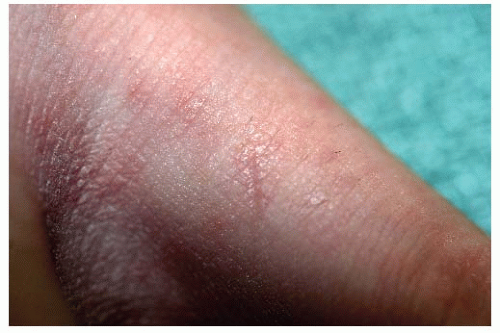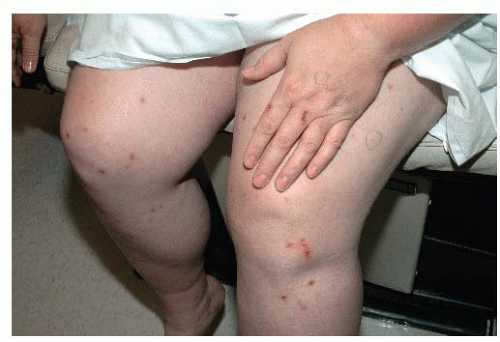Management of Scabies and Pediculosis
Peter C. Schalock
Arthur J. Sober
Scabies and pediculosis are two arthropod parasitic skin diseases commonly seen in the primary care setting. Although accurate diagnosis, effective treatment, and preventive measures are available, infestations with scabies and lice are pandemic, affecting millions of people worldwide. The primary physician should be able to recognize the manifestations of infestation quickly and treat infestations effectively.
Scabies
Infestation with the human skin mite Sarcoptes scabiei var hominis is an extremely common problem worldwide, with an estimated prevalence of 300 million cases. Transmission is through close personal contact, either sexual or nonsexual. Persons of all socioeconomic levels, both sexes, and all age groups can be affected. Once contracted, scabies usually persists until specific therapy is instituted.
The scabies mite is an obligate arachnid human parasite that is unable to live independent of its host for more than 24 to 36 hours; fomite transmission is rare. The mite measures 1/60 inch in length. The adult female mite attaches to and burrows into the horny layer of the skin. Copulation with a wandering male mite renders the female fertile for life. The female mite remains within her burrow for the rest of her 1-month life, laying two or three eggs a day. These eggs hatch within 3 to 4 days. Mature adults develop during the next 10 to 14 days. While in her burrow, the female mite feeds on epidermal cells. The average number of female mites on the body is 11.
Patients usually present with intense pruritus, which is often more severe during the night. Eighty-five percent of infested persons have burrows on the fingers, interdigital areas, and wrists; these appear as linear marks a few millimeters in length, often with a dark dot at one end, which represents the female mite (Fig. 195-1). Other common sites for burrows are the elbows, feet, ankles, penis, scrotum, buttocks, nipples, and axillae. Vigorous scratching may lead to excoriations, eczematous plaques, crusted papules and nodules, or secondary infection (Fig. 195-2). In healthy adults, infestation is usually confined to skin below the neck. However, infant, elderly, or immunosuppressed patients may also present with head and neck lesions.
The mite is not necessarily found in all of the cutaneous lesions. The rash and accompanying pruritus reflect a hypersensitivity reaction to the mite, eggs, or scybala (fecal droppings). In patients who have never been infested, the pruritic rash develops after a 2- to 4-week initial asymptomatic phase of infestation. In previously sensitized patients, the eruption can occur within a few days. Antiscabietic treatment kills the mite and ova but does not remove the sensitizing dead organisms or scybala from the burrow. Thus, pruritus may continue for weeks after treatment, until the contents of the burrow are shed with the natural turnover of skin. Persistent postscabietic papules may occur, especially on the penis, which may require topical or intralesional injection of corticosteroids.
Crusted scabies is an infrequent variant of the disease in which patients harbor a high mite load and present with hundreds of thick, keratotic papules. This form often affects patients with a decreased host defense, such as those with HIV infection, or without the ability to scratch, such those who have had a stroke. Crusted scabies is highly contagious because of the myriad of mites in the exfoliating scales.
Pediculosis
Human lice, which are obligate human parasites, are responsible for the diseases pediculosis capitis, pediculosis corporis, and pediculosis pubis. Transmission is through contact with infested humans, clothing, combs, or bedding. Body lice are most commonly found in people with poor personal hygiene or in indigent populations. Head lice are a public health problem among
school children and affect all socioeconomic classes. Pubic lice are predominantly transmitted sexually. Human lice are the vectors for the transmission of typhus, trench fever, and louseborne relapsing fever.
school children and affect all socioeconomic classes. Pubic lice are predominantly transmitted sexually. Human lice are the vectors for the transmission of typhus, trench fever, and louseborne relapsing fever.
The two species of these wingless, dorsoventrally flattened, blood-sucking insects are Pediculus humanus (subspecies capitis and humanus), which infests the head and clothing respectively, and Phthirus pubis (crab louse), which infests the pubic area. These insects measure 3 to 4 mm in length, with Phthirus pubis demonstrating a more rounded body in comparison with Pediculus humanus. Adult lice require a blood meal every 3 to 6 hours. The female insect lives 1 month and lays 7 to 10 eggs (nits) a day. These eggs hatch in about 8 to 10 days. The head louse lives on the scalp and lays eggs that are cemented onto hairs. Body lice live and lay eggs in clothing, often in the seams. The crab louse prefers axillary, eyebrow, eyelash, beard, pubic, limb, and trunk hairs and lays its eggs on these hairs. Lice may be able to survive away from a human host for 3 days.
The head louse typically infests the occipital portion of the scalp and sometimes the postauricular region. Although few adults are present, many oval nits can be found cemented to the hair. Patients often complain of scalp pruritus. Cervical adenopathy may be present. Body lice cause pruritus, often representing a sensitivity reaction to lice excretions. Patients can have multiple excoriations over the trunk, and vertical excoriations are characteristic of infestation. Body lice and eggs can be seen in clothing. Pubic lice cause pruritus, often nocturnal. Characteristic asymptomatic, macular, blue discolorations called maculae ceruleae are sometimes seen on the trunk and thighs; the mechanism of discoloration is unknown. Lice can be seen grasping pubic hairs, and specks of brownish feces can sometimes be seen.
DIAGNOSIS (2)
Scabies
The diagnosis is suggested by finding the characteristic burrows. They should be sought on the hands, wrists, ankles, and genital areas, where the recovery rate of the organism is highest. A scraping is performed by shaving off the roof of the burrow with a scalpel, scraping the base to remove the contents, and placing the material on a microscope slide. Next, a drop of light mineral oil and a cover slip are added. Alternately, putting a drop of mineral oil on the skin prior to scraping may aid in ensuring that all scale and mites are removed with scraping. The lowestpower objective should be used to view the specimen under a light microscope. The presence of adult mites, immature mites, ova, or tan-brown scybala confirms the diagnosis. In mineral oil, but not in potassium hydroxide, movement of the mite may be seen. In the absence of a scraping, presumptive diagnosis can be made based on the symptoms, the appearance of the rash, and the history of contacts who also have symptoms of itching.
Stay updated, free articles. Join our Telegram channel

Full access? Get Clinical Tree






